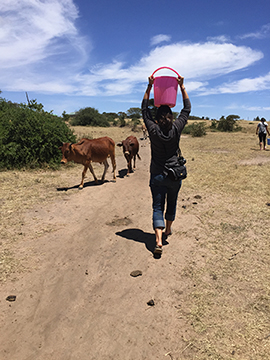Final Thoughts
August 31, 2015

|
"There are some things you can only learn in the valley; you cannot learn them from the mountain top." - Kioko (local Kenyan)
My last days in Nairobi were a whirlwind of activity. Though the school week was over, I wanted to get a feel for the culture and the city so that I would have a more thorough understanding of what life was like. I knew there was no way I could possibly see everything, but I opted to spend some time in two wildly contrasting environments-the city centre of Nairobi and in a Maasai village off the beaten path.
In a lot of ways, Nairobi is much like any other big city in the world: all bustle, smog, and traffic. At rush hour, it can take 2 hours to go 5 km. However, Nairobi is also made of the same fabric as urban areas in developing countries worldwide-the wild juxtaposition between wealth and poverty, progressive development and traditional ways. In Karen, the suburb in which I stayed, the landscape was marked by perfectly manicured lawns inside double-gated communities. Yet on the streets, people walked to work in the red dirt or used matatus (public transit buses covered in airbrushed pictures of pop stars) that swerved around giant potholes on poorly maintained roads. You could never tell when your highway might just dead-end to a gravel road.
As I drove through the city, I requested my driver take me to Kibera, a famously expansive slum which is the largest urban slum in Africa. It's so big and so well known that you can even take tours there. For 20 US dollars, a local will take you through the winding nooks and crannies of Nairobi's poorest community. I opted to skip the tour, but the neighborhood was hard to miss driving along the bypass highway. All I could see were rusty tin roofs stretching for miles and miles. All the roads, whether dirt or tar, were lined with shacks constructed of whatever materials the owner could get their hands on. Buildings were draped with filled clothes lines. It seemed like every available space was filled with either people or trash. I knew from reading that there were around 1 million people living down there, many of them children, many of them infected with HIV and AIDS. I knew that most of the children there didn't go to school. From my vantage point above, it was like looking at an entirely different world. It was hard and overwhelming to imagine what a child's life would be like there, let alone a child with a disability.
From Kibera, I took to the villages. I was lucky enough to tour a Maasai village while in Kenya. The Maasai tribe occupy central Kenya and are well known for their ritual dances, jumping competitions, and colorful red garb. (Anyone who googles "Kenya culture" or looks at the cover of a Kenya tourism book will recognize the characteristic look). Fully operable Maasai villages still exist around Kenya, though they are primarily sustained by tourists visiting to learn about their culture. It's important to note though that tribes still play huge role in the life of Kenyans. Most Kenyans I met in Nairobi were quick to tell me their tribal affiliation and both their "English" name and their tribal name. (The president of the country comes from the Kikuyu tribe, whereas the deputy president is from the Kalenjin tribe).
When I visited the village, what I saw was the complete opposite of the city. The village was made up of a circle of tiny, dark huts made from cow dung. In the center, cows, goats, and sheep milled about. Children clothed in ragged, dirty outfits swallowed me in a laughing, cheerful crowd as they clamored to see my camera screen and give me high fives. The chief's son gave me a tour and told me about how polygamy was still the dominant way of life, and gender roles were still very clearly defined. Women were primarily responsible for cooking, cleaning, caring for children, and foraging for materials to build houses. The men were responsible for tending to the animals, selling them at market, and protecting the village. Most families could not afford to send their children to school. While the village visit was fascinating, it was hard to know how much was real and how much was staged for my benefit. Whether or not they truly wore Maasai clothes and sang Maasai welcomes after I left would always be a mystery, but I do believe the struggle to get clean water, maintain their health, make a living wage, and send their children to school is genuine. It was a struggle I heard echoes of all throughout the country, from the families that came to Kaizora to the people in the villages. It was even being played out on a national stage while I was there-the country's teachers were on strike as they continued a long-standing political battle for higher wages.
The contrast of these two ways of life stayed in my mind as I packed up and left the city. It was hard to make sense of it all. Again, the theme came to mind of passion and perseverance. Everywhere you looked in Kenya, people faced hardships common to developing countries around the world. But they also seemed to be some of the strongest, proudest, and most determined people I had experienced, with a beautiful, rich cultural history. This gave me so much hope for the future. I was so honored to be a guest in their country; to meet so many people and begin to understand life in Kenya. So many amazing people were working so hard to improve life for people with disabilities, and, in fact, all people. Though I was sad that this trip was coming to an end, I was grateful that it was a part of my larger journey.







